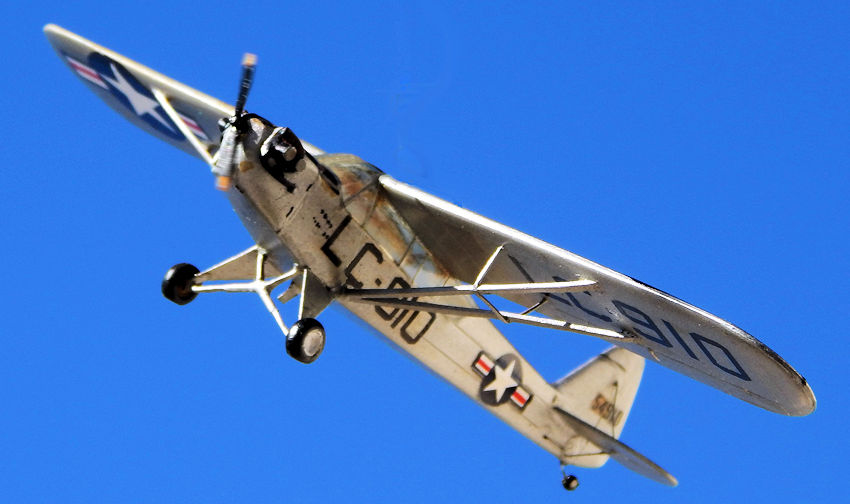
Rareplanes 1/72 Piper L-4
| KIT #: | |
| PRICE: | $10.00 SRP |
| DECALS: | |
| REVIEWER: | Carmel J. Attard |
| NOTES: | Vacuform |

| HISTORY |
Until 1941 the US Army Air Force had operated heavy. Purpose built observation aircraft for reconnaissance, gun-laying and army liaison duties, typified by the Douglas O-43/O-46 series and the North American O-47. During that year, a new concept emerged which utilized standard civilian light planes, such as those made by Piper, Aeroanca, and Taylorcraft, for much the same operations.
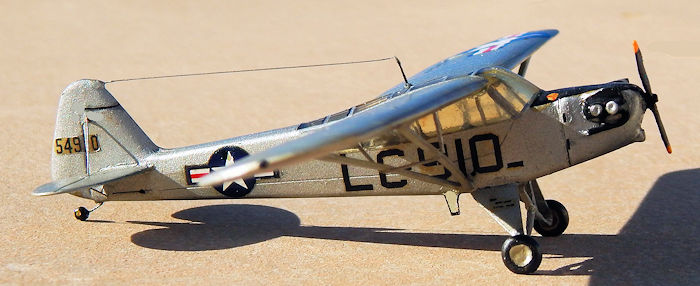 Evaluation tests were so successful that large
production orders were given to all three companies to produce military versions
modified with large window areas and with radio equipment. Probably the most
well known of the trio was the Piper J-3 Cub, which originally carried the
observation designation O-49 before being categorized into the liaison role as
the L-4 Grasshopper.
Evaluation tests were so successful that large
production orders were given to all three companies to produce military versions
modified with large window areas and with radio equipment. Probably the most
well known of the trio was the Piper J-3 Cub, which originally carried the
observation designation O-49 before being categorized into the liaison role as
the L-4 Grasshopper.
The allied landings in North Africa served as the operational debut for the little aircraft in 1943, followed by the invasion of Italy and the D-Day landings of the liberation of France where the communications work became invaluable for all troop movements.
Complete wartime production of all military derivatives, including ambulance versions and gliders, amounted to nearly 6,000 aircraft. Orders continued for the design after WWII and another 2000 were built (L-18 and L-21) until production ceased in 1955.
| THE KIT |
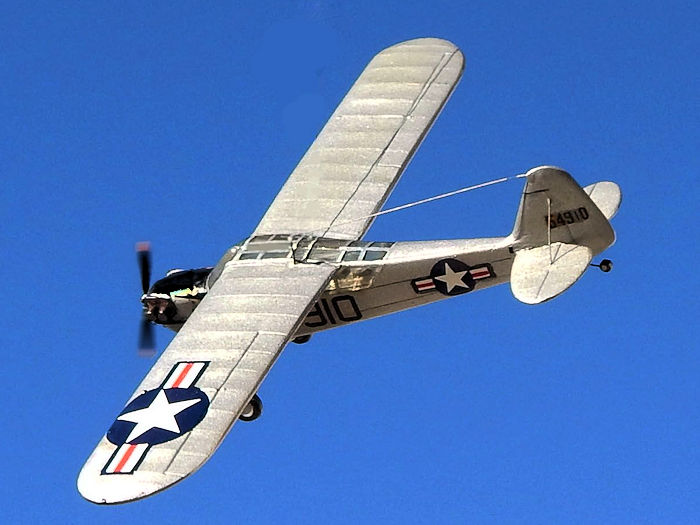 The kit of the L-4 Grasshopper is one of Rareplanes
early kits when no other L-4 kit in any form was being produced. It is vac-form
molded, the two fuselage halves in clear acetate and the rest of kit as wings
prop and other details were formed on a white plastic sheet. The kit has 4 main
plane parts, two tail planes that are shaped to an airfoil section indicated on
the instructions,. The engine mounting, the wing support struts, wheels and
propeller and the rest of parts need to be cut from the sheet of plastic. There
are no decals with the kit and the instructions suggest a single color scheme of
an L-4 that was used as an interim control tower on Omaha Beach airstrip and the
aircraft was in olive drab and neutral gray with black and white Normandy
invasion stripes.
The kit of the L-4 Grasshopper is one of Rareplanes
early kits when no other L-4 kit in any form was being produced. It is vac-form
molded, the two fuselage halves in clear acetate and the rest of kit as wings
prop and other details were formed on a white plastic sheet. The kit has 4 main
plane parts, two tail planes that are shaped to an airfoil section indicated on
the instructions,. The engine mounting, the wing support struts, wheels and
propeller and the rest of parts need to be cut from the sheet of plastic. There
are no decals with the kit and the instructions suggest a single color scheme of
an L-4 that was used as an interim control tower on Omaha Beach airstrip and the
aircraft was in olive drab and neutral gray with black and white Normandy
invasion stripes.
| CONSTRUCTION |
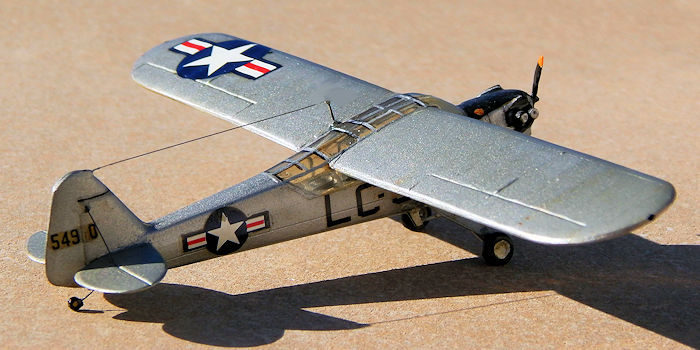 Being a vac form kit it is first cut deeply around
each molded part and is snapped off excess plastic with small players. Edges are
smoothened on wet sheet of wet and dry sand paper, until a good centreline joint
is obtained. The interior details as radio instruments, two cockpit seats,
control column and control panel were prepared and shaped with a sharp blade and
smooth file. The wing struts were however shaped and cut out of Contrail struts.
Cyanoacrylate glue was used for the clear acetate fuselage.
Being a vac form kit it is first cut deeply around
each molded part and is snapped off excess plastic with small players. Edges are
smoothened on wet sheet of wet and dry sand paper, until a good centreline joint
is obtained. The interior details as radio instruments, two cockpit seats,
control column and control panel were prepared and shaped with a sharp blade and
smooth file. The wing struts were however shaped and cut out of Contrail struts.
Cyanoacrylate glue was used for the clear acetate fuselage.
Wing and tail assembly were sanded to ensure correct
airfoil section. Heavier sanding was carried out at wing tips and the trailing
edges to obtain a sharp edge. As for the butt joint of wings to fuselage I found
it 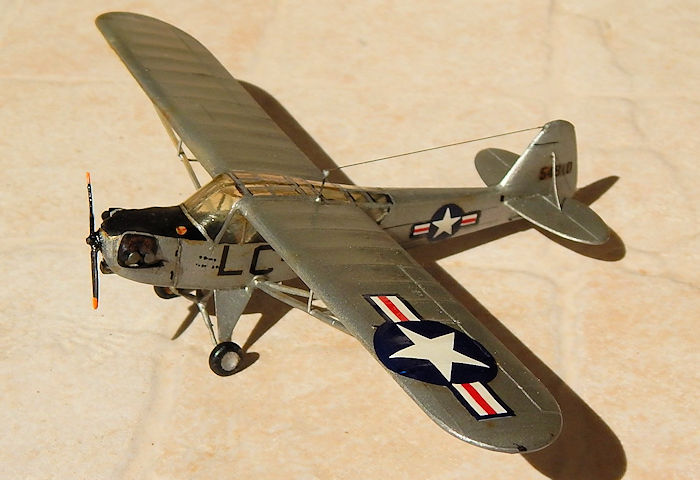 more convenient to add metal pins that insert in predrilled holes in the
fuselage roof section. Tail wheel leg was shaped out of metal wire and the wheel
stuck to it. The forward main gear was shaped with shock absorbers made out of
plastic that was inserted in metal wire legs.
more convenient to add metal pins that insert in predrilled holes in the
fuselage roof section. Tail wheel leg was shaped out of metal wire and the wheel
stuck to it. The forward main gear was shaped with shock absorbers made out of
plastic that was inserted in metal wire legs.
The post war livery applied to the L-4 represented a Grasshopper in USAF markings assigned to Civil Air Patrol CAP with Air Force serial number 54910. It is overall silver finish on fabric and metal parts. Interior was cockpit green with leather brown crew seats. It was given a coat of clear Modelmaster lacquer overall.
| CONCLUSIONS |
This type of kit is aimed at the experienced modeler who can go that step further to add extra detail that may be lacking in vac kits. I doubt if the kit is still available though it may appear from time to time on e-bay. Still it is a kit that does not take much space and a gap is filled for the type used important duties as air observation aircraft.
December 2015
Copyright ModelingMadness.com
If you would like your product reviewed fairly and fairly quickly, please contact the editor or see other details in the Note to Contributors.